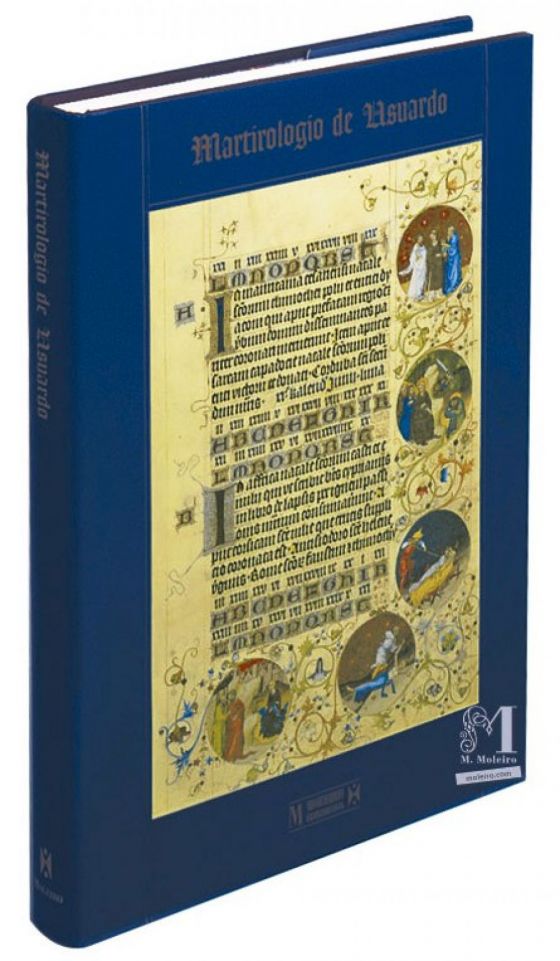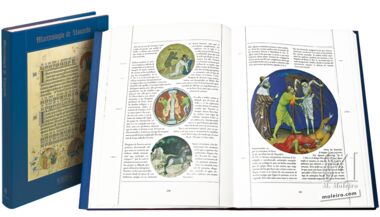


+ 9

Before reaching the city of Gerona, the Martyrology of Usuard had an eventful life. It originated in Prague, in the court of the king of Bohemia and emperor Wenceslas IV. It has now been in Catalonia for more than three centuries although according to our information, after leaving Prague it moved to Austria, Hungary and then Moravia. It was subsequently in Rome and later in Naples. It may have been housed for a while in Stockholm and Madrid prior to its arrival in Poblet in 1673. As fate would have it, it was taken to Gerona where it was safeguarded at first in Cadins monastery and subsequently in the Museu Diocesà, in Gerona where it remains to this day.
The Martyrology is a copy of the work completed by Usuard in 860, only part of which has been retouched to include later saints. We know that from 841 to 847 Usuard was a monk at Saint-Germain-des-Prés in Paris. His journey through Spain in 858 was decisive as regards the incorporation of Spanish saints into the martyrology that he was working on in that period.
This manuscript plays a key role in the history of Central-European painting. The links between its illuminations and the activities of the leading artistic centres of Europe on the borderline between the 14th and 15th centuries enable this great work to be situated in the ambit of international courtly art. Similarly, the Martyrology of Usuard falls within the local bohemian tradition of book illumination, constituting a high point in its long evolution.
Unanimously deemed to be the most lavish work in International Gothic.
Leggi di più
Leggi meno
Before reaching the city of Gerona, the Martyrology of Usuard had an eventful life. It originated in Prague, in the court of the king of Bohemia and emperor Wenceslas IV. It has now been in Catalonia for more than three centuries although according to our information, after leaving Prague it moved to Austria, Hungary and then Moravia. It was subsequently in Rome and later in Naples. It may have been housed for a while in Stockholm and Madrid prior to its arrival in Poblet in 1673. As fate would have it, it was taken to Gerona where it was safeguarded at first in Cadins monastery and subsequently in the Museu Diocesà, in Gerona where it remains to this day.
The Martyrology is a copy of the work completed by Usuard in 860, only part of which has been retouched to include later saints. We know that from 841 to 847 Usuard was a monk at Saint-Germain-des-Prés in Paris. His journey through Spain in 858 was decisive as regards the incorporation of Spanish saints into the martyrology that he was working on in that period.
This manuscript plays a key role in the history of Central-European painting. The links between its illuminations and the activities of the leading artistic centres of Europe on the borderline between the 14th and 15th centuries enable this great work to be situated in the ambit of international courtly art. Similarly, the Martyrology of Usuard falls within the local bohemian tradition of book illumination, constituting a high point in its long evolution.
Unanimously deemed to be the most lavish work in International Gothic.
Formato: 267 x 377 mm
Pagine: 410
Illustrazioni: 170
Lingua: Spagnolo
ISBN: 978-84-88526-35-9
SOMMARIO:
Del editor al lector
Prefacio
Jaume Camprodon (†) (Obispo de Girona)
El Martirologio y el Museo Diocesano de Girona
Mª Rosa Ferrer (Museo Diocesano de Girona)
Estudio codicológico
Mª Josefa Arnall (†) (Universidad de Barcelona)
Estudio pelaográfico
Gabriel Roura (†) (Archivo Capitular de Girona)
Las iluminaciones del Martirologio de Usuardo
Milada Studnicková (Akademie ved Ceské republiky Ústav Dejin Umení)
Esbozo del análisis iconográfico en el Martirologio de Usuardo
Joaquín Yarza Luaces (Catedrático emérito de Historia del Arte en la Universidad Autónoma de Barcelona).
Transcripción
Gabriel Roura (†)
Traducción
Cristina Gómez i Morell

Formato: 267 x 377 mm
Pagine: 410
Illustrazioni: 170
Lingua: Spagnolo
ISBN: 978-84-88526-35-9
SOMMARIO:
Del editor al lector
Prefacio
Jaume Camprodon (†) (Obispo de Girona)
El Martirologio y el Museo Diocesano de Girona
Mª Rosa Ferrer (Museo Diocesano de Girona)
Estudio codicológico
Mª Josefa Arnall (†) (Universidad de Barcelona)
Estudio pelaográfico
Gabriel Roura (†) (Archivo Capitular de Girona)
Las iluminaciones del Martirologio de Usuardo
Milada Studnicková (Akademie ved Ceské republiky Ústav Dejin Umení)
Esbozo del análisis iconográfico en el Martirologio de Usuardo
Joaquín Yarza Luaces (Catedrático emérito de Historia del Arte en la Universidad Autónoma de Barcelona).
Transcripción
Gabriel Roura (†)
Traducción
Cristina Gómez i Morell
Utilizziamo cookie propri e di terzi per migliorare i nostri servizi analizzando le vostre abitudini di navigazione. Per ulteriori informazioni è possibile leggere la nostra politica sui cookie. È possibile accettare tutti i cookie facendo clic sul pulsante Accetta oppure configurare o rifiutare il loro utilizzo facendo clic QUI.











